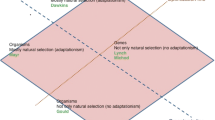Abstract
The Formal Darwinism Project aims to provide a formal argument linking population genetics to fitness optimization, which of necessity includes defining fitness. This bridges the gulf between those biologists who assume that natural selection leads to something close to fitness optimization and those biologists who believe on theoretical grounds that there is no sense of fitness that can usefully be said to be optimized. The current paper’s main objective is to provide a careful mathematical introduction to the project, and it also reflects on the project’s scope and limitations. The central argument is the proof of close ties between the mathematics of motion, as embodied in the Price equation, and the mathematics of optimization, as represented by optimization programmes. To make these links, a general and abstract model linking genotype, phenotype and number of successful gametes is assumed. The project has begun with simple dynamic models and simple linking models, and its progress will involve more realistic versions of them. The versions given here are fully mathematically rigorous, but elementary enough to serve as an introduction.
Similar content being viewed by others
References
Burt A. and Trivers R. L. 2005 Genes in conflict: the biology of selfish genetic elements. Massachusetts: Harvard University Press, Cambridge.
Darwin C. R. 1859 The origin of species. John Murray, London.
Darwin C. R. 1871 The descent of man and selection in relation to sex. John Murray, London.
Dawkins R. 1976 The selfish gene. Oxford University Press.
Dawkins R. 1982 The extended phenotype. W. H. Freeman, Oxford.
Edwards A. W. F. 1994 The fundamental theorem of natural selection. Biol. Rev. 69, 443–474.
Ewens W. J. 1979 Mathematical population genetics. Springer, Berlin.
Ewens W. J. 1989 An interpretation and proof of the fundamental theorem of natural selection. Theor. popul. biol. 36, 167–180.
Ewens W. J. 1992 An optimizing principle of natural selection in evolutionary population genetics. Theor. Popul. Biol. 42, 333–346.
Ewens W. J. 2004 Mathematical population genetics I. theoretical introduction. Springer, Berlin.
Fisher R. A. 1930 The genetical theory of natural selection. Oxford University Press. OUP published in 1999 a variorum edition of the 1930 and 1958 editions, Oxford.
Frank S. A. 1998 The foundations of social evolution. Princeton University Press, Princeton.
Grafen A. 1985 A geometric view of relatedness. Oxf. Surv. Evol. Biol. 2, 28–89.
Grafen A. 1999 Formal Darwinism, the individual-as-maximisingagent analogy, and bet-hedging. Proc. R. Soc. Ser. B 266, 799–803.
Grafen A. 2000 Developments of Price’s equation and natural selection under uncertainty. Proc. R. Soc. Ser. B 267, 1223–1227.
Grafen A. 2002 A first formal link between the Price equation and an optimization program. J. Theor. Biol. 217, 75–91.
Grafen A. 2003 Fisher the evolutionary biologist. J. R. Stat. Soc. Ser. D (The statistican) 52, 319–329.
Grafen A. 2006a Optimisation of inclusive fitness. J. Theor. Biol. 238, 541–563.
Grafen A. 2006b A theory of Fisher’s reproductive value. J. Math. Biol. 53, 15–60. Doi: 10.1007/s00285-006-0376-4.
Grafen A. 2007a Detecting kin selection at work using inclusive fitness. Proc. R. Soc. Ser. B 274, 713–719.
Grafen A. 2007b The formal Darwinism project: a mid-term report. J. Evol. Biol. 20, 1243–1254.
Grafen A. 2007c Inclusive fitness on a cyclical network. J. Evol. Biol. 20, 2278–2283.
Hamilton W. D. 1964 The genetical evolution of social behaviour. J. Theor. Biol. 7, 1–52.
Hamilton W. D. 1967 Extraordinary sex ratios. Science 156, 477–488.
Hamilton W. D. 1970 Selfish and spiteful behaviour in an evolutionary model. Nature 228, 1218–1220.
Hamilton W. D. 1975 Innate social aptitudes of man: an approach from evolutionary genetics. In: Biosocial Anthropology (ed. R. Fox), pp. 133–153. Malaby Press, London.
Killingback T. Bieri J. and Flatt T. 2006 Evolution in groupstructured populations can resolve the tragedy of the commons. Proc. R. Soc. Ser. B 273, 1477–1481.
Lehmann L. and Keller L. 2006 The evolution of cooperation and altruism: a general framework and a classication of models. J. Evol. Biol. 19, 1365–1376.
Lehmann L., Keller L. and Sumpter D. 2007 The evolution of helping and harming on graphs: the return of the inclusive fitness effect. J. Evol. Biol. 20, 2284–2295.
Lewontin R. C. 1974 The genetic basis of evolutionary change. Columbia University Press, New York.
Maynard Smith J. 1982 Evolution and the theory of games. Cambridge University Press, Cambridge.
Maynard Smith J. and Price G. R. 1973 The logic of animal conflict. Nature 246, 15–18.
Ohtsuki H., Hauert C., Lieberman E. and Nowak M. 2006 A simple rule for the evolution of cooperation on graphs and social networks. Nature 441, 502–505.
Price G. R. 1970 Selection and covariance. Nature 227, 520–521.
Price G. R. 1972a Extension of covariance selection mathematics. Ann. Hum. Genet. 35, 485–490.
Price G. R. 1972b Fisher’s ‘fundamental theorem’ made clear. Ann. Hum. Genet. 36, 129–140.
Queller D. C. 1992 A general model for kin selection. Evolution 46, 376–380.
Schechter E. 1997 Handbook of analysis and its foundations. Academic Press, San Diego.
Schwartz J. 2002 Population genetics and sociobiology: conflicting views of evolution. Perspect. Biol. Med. 45, 224–240.
Segestrale U. 2000 Defenders of the truth. Oxford University Press, New York.
Williams G. C. 1966 Adaptation and natural selection. Princeton University Press, Princeton.
Author information
Authors and Affiliations
Corresponding author
Rights and permissions
About this article
Cite this article
Grafen, A. The simplest formal argument for fitness optimization. J Genet 87, 421–433 (2008). https://doi.org/10.1007/s12041-008-0064-9
Received:
Accepted:
Published:
Issue Date:
DOI: https://doi.org/10.1007/s12041-008-0064-9




